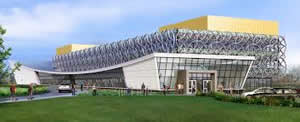Connecticut High School Opens in Time for the New School Year
 The new Harding High School in Bridgeport, Conn., recently wrapped up construction in time for the 2018 school year. The new facility replaces an older high school building that had been in use since 1925. The new school features computer labs, new science labs, and a student health center.
The new Harding High School in Bridgeport, Conn., recently wrapped up construction in time for the 2018 school year. The new facility replaces an older high school building that had been in use since 1925. The new school features computer labs, new science labs, and a student health center.
Totaling 207,000 square feet, the new high school will serve roughly 1,150 students in the Bridgeport area. Aside from academic and social spaces, the new facility will also feature a day care center. The new Harding High School opened with the start of the school year in late August 2018.